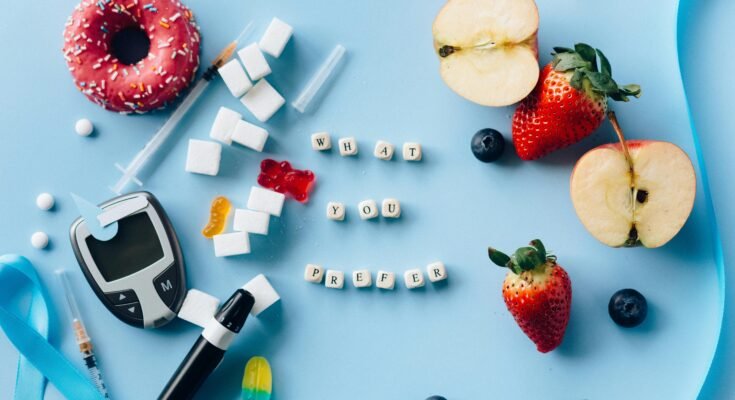Introduction
In our modern, busy environment, blood-sugar level management has never been more essential. With the rising numbers of people with prediabetes or diabetes, managing blood-sugar levels is of high importance. Exercise and medication can help manage glucose levels, but diet is the most important part of effective blood-sugar management. Like in many things, there are good and bad foods that affect blood-sugar levels. The best foods will help stabilize glucose levels, limit blood-sugar spikes, and can even help reverse insulin resistance. Regardless of whether you are managing diabetes or trying to improve your metabolic health, understanding diet’s role is critical.
In this article, we will discuss foods, timing of meals, and patterns of eating that can all be a helpful influence on blood sugar levels, as well as give quick ideas and suggestions that you can implement to take charge of your health.
Why Is Blood Sugar Balance Important?
Blood sugar (glucose) is the primary energy source for the body. The glucose comes from food (especially carbohydrates) in the diet. Insulin, made by the pancreas, is a hormone that allows your cells to absorb glucose for energy use. When this normal process goes awry, you get conditions like type 2 diabetes or insulin resistance, and glucose builds up in the blood, which causes many health complications.
Having chronically high blood sugar can lead to damage to blood vessels, nerves, and organs, which can lead to increased risk of heart disease, kidney failure, vision problems, etc. The good news is, diet can be a major contributor to either preventing or managing these complications.
Key Diet Principles for Managing Blood Sugar Levels
1.Eat Low Glycemic Index (GI) Foods.
The glycemic index (GI) refers to the speed which a food will increase blood sugar levels. The foods with a high glycemic index (GI), such as white bread, candy, and soda, cause fast spikes in glucose levels. Foods with a low glycemic index (such as lentils, oats, and leafy greens) result in a slow rise in glucose levels.
Some examples of top low-GI foods are:
- Steel cut oats
- Sweet potatoes
- Chickpeas and lentils
- Quinoa
- Berries
- Non-starchy vegetables
By adding some low-GI foods as a regular part of your daily eating plan, you will help to maintain a somewhat steady glucose profile.
2.Consume Foods High in Fiber
Dietary fiber (more specifically soluble fiber) delays sugar absorption in the bloodstream. Soluble fiber increases insulin sensitivity and allows for prolonged satiety, mitigating overeating.
Some examples of fiber rich foods are:
- Whole grains (brown rice, barley)
- Legumes (beans, peas, lentils)
- Fruits (apples, pears – with skin)
- Vegetables (broccoli, Brussels sprouts)
- Chia seeds and flaxseeds.
Aiming for a daily intake of 25-30 grams of fiber is considered optimal.
3.Combine Carbohydrates with Proteins and Fats
Carbohydrates alone can lead to blood sugar spikes. However, combining carbohydrates with lean proteins and healthy fats will slow absorption of glucose.
For example, a balanced meal consists of grilled chicken, quinoa, steamed broccoli, and drizzle of olive oil.
Examples of healthy protein sources:
- Eggs
- Tofu
- Fatty fish (salmon, sardines)
- Greek yogurt
Examples of healthy fats:
- Avocados
- Nuts and seeds
- Olive oil
- Fatty fish
This combination does not only provide support for blood sugar but also provides additional energy and satiety.
4.Practice Portion Control
Eating too much of any carbohydrate – even healthy carbohydrates – can produce an increase in blood sugar. Addressing portion control is necessary.
Suggestions:
Use smaller plates
Fill half your plate with vegetables
Keep carbs to a quarter of your plate
Avoid second helpings
Tools like plate method can help simplify meal planning and help maintain glucose levels steady.
5.Don’t Eat Refined Sugars and Processed Foods
Refined sugars and more importantly ultra-processed foods are the biggest factors for blood sugar imbalance. These foods are usually low in fiber and nutrients and greatly high in simple carbs, which brings blood glucose up quickly.
Foods to Limit or Avoid Include:
Soda, sweetened juices
White bread, cakes
Packaged snacks
Candy and sweets
Try to use natural sweeteners like stevia and monk fruit, and focus on whole, nutrient-rich foods.
Timing and Frequency: When You Eat Matters
Not only does what you eat matter, but when and how often you eat can influence blood sugar.
Best Practices:
Eat regularly to avoid spikes and crashes.
Don’t skip meals—especially do not skip breakfast.
Avoid big meals at night (especially late).
Intermittent fasting may offer some benefits depending on your lifestyle and if you are insulin resistant. Check with your doctor before trying a new way of eating, including intermittent fasting.
Superfoods that Help Lower Blood Sugar Naturally
Some foods are high in compounds that actually help lower or regulate blood sugars. Using these foods in your meal plans can help maximize the activity of your meal plan.Top Blood Sugar-Friendly Superfoods:
Cinnamon: Enhances insulin sensitivity
Apple cider vinegar: Aids in reducing glucose spikes after meals
Turmeric: Contains curcumin, which supports insulin’s ability to work
Garlic and onions: Have anti-inflammatory benefits and may lower blood glucose
Bitter melon: Traditionally used to help manage blood sugar with diabetes
Adding any of these (in moderation) can add flavor and nutritional value.
Hydration: The Forgotten and Overlooked Part of Healthy Eating
Drinking enough water is a key factor in reducing and flushing excess sugar out of the bloodstream, as well as procuring optimal function.
You will want to aim for at least 8 – 8 oz glasses a day; limit sugary drinks, as they do the opposite.
Best Choices:
Water
Herbal teas (for example, green tea, chamomile)
Infused water with few slices of lemon, cucumber, or mint
To learn more about how meal planning in diet works, check out our article on Meal Planning Tips to Support Weight Loss and Muscle Gain
Lifestyle Add-Ons to Help You Get The Most From Your Eating Plan
Although your eating plan is the primary factor in controlling blood sugar, there are a few other healthy habits that can help you maximize the effectiveness of your diet and exercise:
Exercise regularly: Movement helps your cells utilize glucose better
Control stress: Being under chronic stress increases cortisol, which increases blood sugar
Sleep well: Poor sleep can negatively impact hormones that control hunger and insulin sensitivity.
In sum, using these changes together creates a comprehensive blood sugar management plan.
Final Thoughts
Diet is a powerful tool in blood sugar management, whether you are preventing diabetes or looking to control a blood sugar issue, it can be done naturally. Simply choosing the right foods, watching portions, eating at the right time, and using supportive habits all play a significant role in blood sugar management. By using the right foods in your eating pattern – you can easily master blood glucose levels and enjoy a healthier, more energetic lifestyle.
Most importantly, always remember it is not “what you cannot eat” but rather “what you can eat.” You need to make smart, informative, and sustainable choices. A small dietary change today can help with impactful change tomorrow.
FAQ
- Can I eat carbs to manage blood sugar?
Yes, but choose carbohydrates that are complex, low in sugar, and provide beneficial fiber. By including protein and/or fat with the carbohydrate you can decrease the moderate increase in glucose. - Can fruits be helpful in managing blood sugar?
Yes, however, the best fruits to use are those that rate low on the glycemic index (GI), such as berries, apples, and pears – avoid juices and canned fruits in syrup. - What is the best breakfast for managing blood sugar?
You will want the first meal of the day to contain a higher portion of protein and fiber, such as eggs and avocado toast on whole-grain bread.



